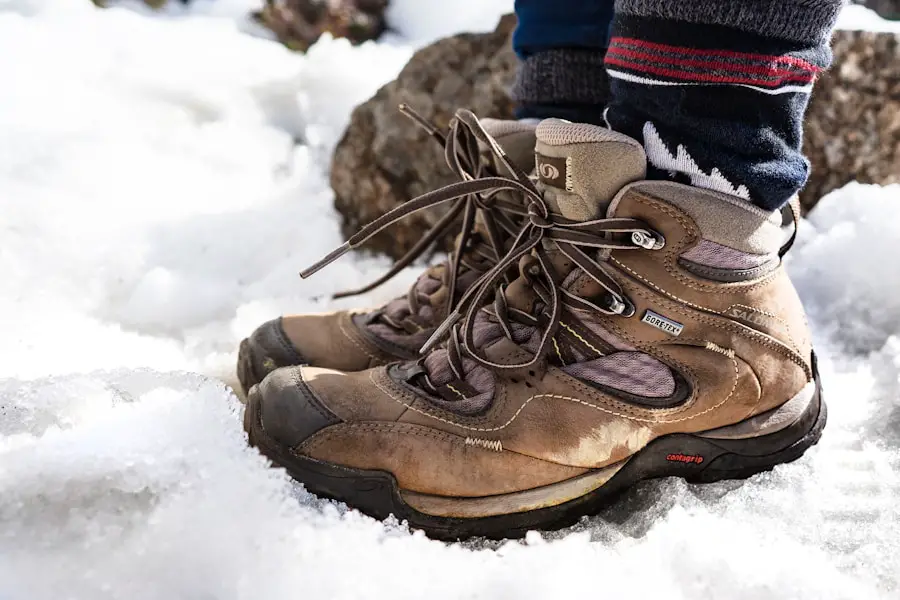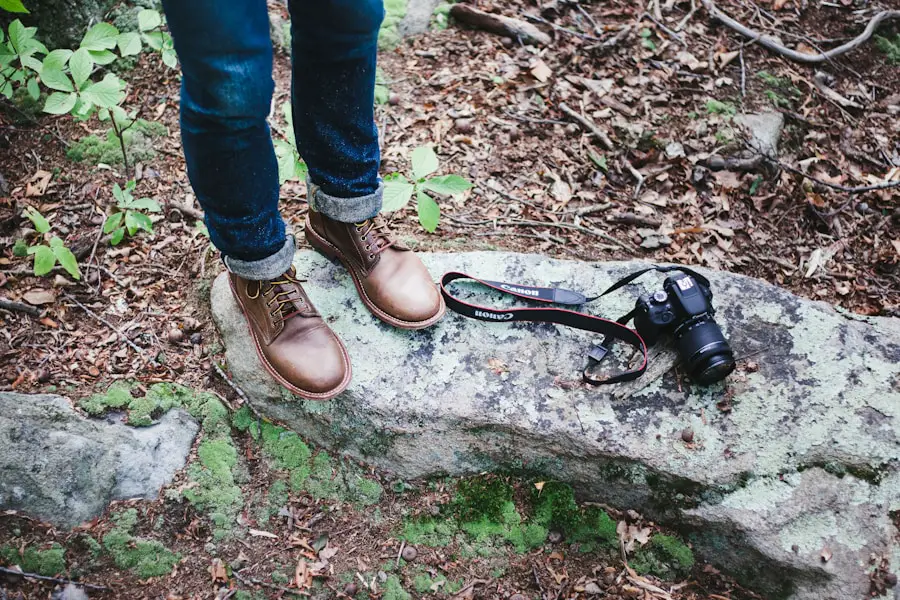The significance of a proper fit in hiking boots cannot be overstated. When embarking on a hiking adventure, the right footwear serves as the foundation for your entire experience. A well-fitted boot not only enhances comfort but also plays a crucial role in preventing injuries.
Hiking often involves traversing uneven terrain, steep inclines, and rocky paths, all of which can put immense pressure on your feet. If your boots do not fit correctly, you may find yourself dealing with blisters, calluses, or even more severe issues like sprained ankles or plantar fasciitis. The right fit allows for natural foot movement while providing the necessary support to tackle various hiking conditions.
Moreover, a proper fit contributes to overall performance on the trail. When your boots are snug yet comfortable, you can maintain better balance and stability, which is essential when navigating challenging landscapes. A boot that fits well will also help in the efficient transfer of energy from your legs to the ground, allowing for a more effective stride.
This is particularly important during long hikes where fatigue can set in quickly. Therefore, understanding the importance of proper fit is not just about comfort; it is about enhancing your hiking experience and ensuring safety on the trail.
Key Takeaways
- Proper fit is crucial for hiking boots to prevent discomfort and injury
- Consider factors such as terrain, weather, and personal preferences when choosing hiking boots
- Sizing up in hiking boots can provide extra room for thick socks and foot swelling
- Sizing up may lead to blisters, discomfort, and lack of stability in hiking boots
- Determine the right size for hiking boots by measuring your feet and trying on different sizes
- Ensure a comfortable fit by testing boots with the right socks and walking around in them
- Wearing ill-fitting hiking boots can result in blisters, hot spots, and even foot injuries
- Consider factors such as arch support, toe room, and break-in period when choosing the right size for hiking boots
Factors to Consider When Choosing Hiking Boots
Choosing the right hiking boots involves several critical factors that go beyond mere aesthetics or brand loyalty. One of the primary considerations is the type of terrain you plan to hike. For instance, if you are tackling rugged mountain trails, you will need boots with a stiffer sole and more aggressive tread patterns for better grip and support.
Conversely, if your hikes are primarily on well-maintained paths, a lighter boot with more flexibility may suffice. Understanding the specific demands of your hiking environment will guide you in selecting the most appropriate footwear. Another essential factor is the material of the boots.
Hiking boots are typically made from leather, synthetic materials, or a combination of both. Leather offers durability and water resistance but can be heavier and require a break-in period. Synthetic materials, on the other hand, tend to be lighter and more breathable but may not provide the same level of durability as leather.
Additionally, consider insulation if you plan to hike in colder climates; insulated boots can keep your feet warm but may sacrifice breathability in warmer conditions. Evaluating these factors will help you make an informed decision that aligns with your hiking style and environmental conditions.
The Case for Sizing Up in Hiking Boots

One argument for sizing up in hiking boots revolves around the natural swelling of feet during physical activity. As you hike, blood flow increases to your extremities, causing your feet to swell slightly. This phenomenon can lead to discomfort if your boots are too snug.
By opting for a half size or even a full size larger than your regular shoe size, you allow for this natural expansion, reducing the risk of blisters and other foot ailments. Additionally, a slightly larger boot can accommodate thicker socks, which may be necessary for colder weather or longer hikes. Another consideration is the potential for foot movement within the boot itself.
A little extra space can provide room for your toes to wiggle and shift without feeling cramped. This is particularly important during descents when your toes may push against the front of the boot due to gravity. A boot that is too tight can lead to painful toe jams and long-term damage to your toenails.
Therefore, sizing up can be a practical solution to ensure that your feet remain comfortable and protected throughout your hike.
The Case Against Sizing Up in Hiking Boots
| Study | Findings |
|---|---|
| University of Utah Study | Found that hikers who wore larger boots had a higher risk of ankle injuries |
| Journal of Foot and Ankle Research | Reported that wearing boots that are too big can lead to blisters and discomfort |
| OutdoorGearLab | Concluded that properly fitting boots provide better stability and support |
While there are valid reasons for considering a larger size in hiking boots, there are also compelling arguments against this approach. One significant concern is that oversized boots can lead to instability and lack of support. If your foot has too much room to move around inside the boot, it can result in blisters and chafing as your foot slides against the interior lining with each step.
This movement can also compromise your balance, making it more challenging to navigate uneven terrain safely. Furthermore, sizing up may lead to a loss of precision in foot placement. When hiking on technical trails that require careful footwork, having a boot that fits too loosely can hinder your ability to feel the ground beneath you.
This lack of connection can result in missteps or slips that could have been avoided with a properly fitted boot. Therefore, while it may be tempting to size up for comfort, it is crucial to weigh these potential drawbacks against the benefits.
How to Determine the Right Size for Your Hiking Boots
Determining the right size for hiking boots involves more than just measuring your foot length; it requires a comprehensive approach that considers various factors. Start by measuring both feet at the end of the day when they are most likely to be swollen. Use a Brannock device or a ruler to measure from heel to toe and across the widest part of your foot.
It’s essential to note that many people have one foot larger than the other; always fit for the larger foot to ensure comfort. Once you have your measurements, consult the sizing chart provided by the manufacturer, as sizes can vary significantly between brands and models. Trying on multiple pairs is advisable; wear the socks you intend to use while hiking and walk around in the boots for at least 10-15 minutes.
Pay attention to how they feel during this time—your toes should not touch the front of the boot when standing upright, but there should be minimal movement when walking downhill. Additionally, consider how the arch support aligns with your foot’s natural shape; inadequate support can lead to discomfort over long distances.
Tips for Ensuring a Comfortable Fit

To ensure a comfortable fit in your hiking boots, consider several practical tips that can enhance your overall experience on the trail. First and foremost, invest time in breaking in your boots before hitting the trails. New boots often require a break-in period during which they mold to the shape of your feet.
Start by wearing them around your home or on short walks to allow them to flex and adjust without subjecting yourself to long hikes right away. Another useful tip is to experiment with different sock combinations. The thickness and material of your socks can significantly impact how your boots fit and feel.
Merino wool socks are popular among hikers due to their moisture-wicking properties and cushioning capabilities. If you find that your boots feel too loose with regular socks, consider using thicker ones or adding an insole for extra support and comfort. Additionally, always ensure that laces are tightened appropriately; improper lacing can lead to heel slippage or excessive pressure points.
Potential Consequences of Wearing Ill-Fitting Hiking Boots
Wearing ill-fitting hiking boots can lead to a myriad of consequences that extend beyond mere discomfort. One of the most common issues is blister formation, which occurs when friction between your skin and the boot creates irritation. Blisters can quickly turn an enjoyable hike into a painful ordeal, forcing you to cut your trip short or even seek medical attention if they become infected.
Beyond blisters, chronic issues such as plantar fasciitis or tendonitis can arise from inadequate support or improper fit over time. These conditions can lead to persistent pain that affects not only your hiking activities but also daily life. In severe cases, wearing ill-fitting boots may result in long-term damage to ligaments or tendons in your feet and ankles, necessitating physical therapy or surgery for correction.
Therefore, investing time and effort into finding the right fit is essential for both immediate comfort and long-term foot health.
Final Considerations for Choosing the Right Size
When choosing the right size for hiking boots, it’s essential to remember that comfort should always take precedence over style or brand reputation. While it may be tempting to choose a popular model based on recommendations from friends or online reviews, personal fit is paramount. Each individual’s foot shape is unique; what works for one person may not work for another.
Additionally, consider seasonal variations when selecting hiking boots. If you plan on hiking in different weather conditions throughout the year, you might need multiple pairs tailored for specific environments—such as waterproof boots for wet conditions or breathable options for summer hikes. Ultimately, taking the time to assess all these factors will lead you toward making an informed decision that enhances both comfort and performance on every adventure you undertake in nature’s vast playgrounds.
If you’re considering investing in a new pair of hiking boots, you may also want to check out this article on 5 Must-Have Portable Water Bottles for Your Spring 2025 Adventures. Staying hydrated is crucial while out on the trails, and having a reliable water bottle can make all the difference. Just like finding the right fit for your hiking boots, choosing the perfect water bottle for your outdoor excursions is essential for a successful and enjoyable experience.
FAQs
What are the benefits of sizing up in hiking boots?
Sizing up in hiking boots can provide more room for your toes, reduce the risk of blisters and hot spots, and accommodate thicker socks for added warmth and comfort.
When should you consider sizing up in hiking boots?
You should consider sizing up in hiking boots if you have wide feet, plan to wear thicker socks, or if you experience discomfort or pressure points in your current size.
How much should you size up in hiking boots?
It is recommended to size up by half a size to a full size in hiking boots to allow for extra room and comfort, especially if you plan to wear thicker socks or if you have wide feet.
What are the potential drawbacks of sizing up in hiking boots?
Sizing up too much in hiking boots can lead to an improper fit, reduced stability, and an increased risk of tripping or slipping on uneven terrain. It is important to find the right balance between extra room and a secure fit.
How can you determine the right size for hiking boots?
To determine the right size for hiking boots, it is recommended to measure your feet, consider the type of socks you will be wearing, and try on different sizes while standing and walking to ensure a proper fit.
